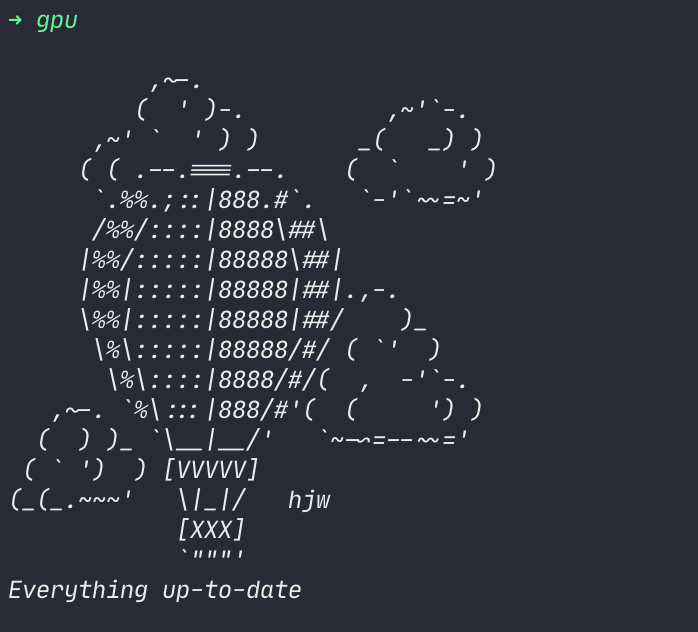CodinGame: ASCI Art - Rust, NodeJs - Strings, Arrays, Loops
Solving this puzzle teaches how to manage strings and array arithmetics. You'll know how to split a string into separate parts and concatenate them into a new one. You can use indexes of arrays

The goal of the problem is to simulate an old airport terminal display: your program must display a line of text in ASCII art.
You have to split strings, store them and recreate others. You can use data structures like arrays or hash tables.
It can be solved using the following concepts.
The Goal
In stations and airports you often see this type of screen:

Have you ever asked yourself how it might be possible to simulate this display on a good old terminal? We have: with ASCII art!
Rules
ASCII art allows you to represent forms by using characters. To be precise, in our case, these forms are words. For example, the word "MANHATTAN" could be displayed as follows in ASCII art:
# # # ### # # # ### ### # ###
### # # # # # # # # # # # # # #
### ### # # ### ### # # ### # #
# # # # # # # # # # # # # # # #
# # # # # # # # # # # # # # # #Your mission is to write a program that can display a line of text in ASCII art in a style you are given as input.
Game Input
Input
Line 1: the width L of a letter represented in ASCII art. All letters are the same width.
Line 2: the height H of a letter represented in ASCII art. All letters are the same height.
Line 3: The line of text T, composed of N ASCII characters.
Following lines: the string of characters ABCDEFGHIJKLMNOPQRSTUVWXYZ? Represented in ASCII art.
Output
The text T in ASCII art.
The characters a to z are shown in ASCII art by their equivalent in upper case.
The characters that are not in the intervals [a-z] or [A-Z] will be shown as a question mark in ASCII art.
Constraints
0 < L < 30
0 < H < 30
0 < N < 200
Example 1
Input
4
5
E
# ## ## ## ### ### ## # # ### ## # # # # # ### # ## # ## ## ### # # # # # # # # # # ### ###
# # # # # # # # # # # # # # # # # ### # # # # # # # # # # # # # # # # # # # # # # # #
### ## # # # ## ## # # ### # # ## # ### # # # # ## # # ## # # # # # # ### # # # ##
# # # # # # # # # # # # # # # # # # # # # # # # # # ## # # # # # # # # ### # # # #
# # ## ## ## ### # ## # # ### # # # ### # # # # # # # # # ## # ### # # # # # # ### # Output
###
#
##
#
### Example 2
Input
4
5
MANHATTAN
# ## ## ## ### ### ## # # ### ## # # # # # ### # ## # ## ## ### # # # # # # # # # # ### ###
# # # # # # # # # # # # # # # # # ### # # # # # # # # # # # # # # # # # # # # # # # #
### ## # # # ## ## # # ### # # ## # ### # # # # ## # # ## # # # # # # ### # # # ##
# # # # # # # # # # # # # # # # # # # # # # # # # # ## # # # # # # # # ### # # # #
# # ## ## ## ### # ## # # ### # # # ### # # # # # # # # # ## # ### # # # # # # ### # Output
# # # ### # # # ### ### # ###
### # # # # # # # # # # # # # #
### ### # # ### ### # # ### # #
# # # # # # # # # # # # # # # #
# # # # # # # # # # # # # # # # Source
This exercise can be found on codingame.com

Solution in NodeJs
We will have three directories: node, rust and cases with text inputs and outputs files. In node we can setup project using commands
npm init -y
tsc --initin tsconfig.json we will change target to ESNext to be able to use padEnd in our code. Additionally we should install dev dependencies:
npm i -D @types/node typescriptReading lines
We want to pass input by standard input to program. Using module readline we can listen on lines and end of input. Any line will be added to lines array. When all input will be read, we will call start function that we will define later.
import readlineModule from "readline";
const rl = readlineModule.createInterface({
input: process.stdin,
output: process.stdout,
terminal: false
});
const lines: string[] = [];
let readIndex = 0;
rl.on('line', (line: string) => {
lines.push(line)
});
rl.on('close', () => {
start();
})
function readline() {
return lines[readIndex++];
}Additionally we defined readline function that will give us next lines from lines array.
Interface of class that process input
We will create class Alphabet that will need size of letter in constructor. Then we will save rows one by one and finally we need get array of rows for given string. We will focus on implementation later, but now let's see start function mentioned before:
function start() {
const L: number = parseInt(readline());
const H: number = parseInt(readline());
const T: string = readline();
const a = new Alphabet(L, H);
for (let i = 0; i < H; i++) {
const ROW: string = readline();
a.setRow(ROW);
}
const res = a.get(T);
res.forEach((row) => {
console.log(row.replace(/\s+$/, ''));
});
}this function will be called when input will be saved to lines. Now we can focus on implementation of Alphabet
Processing rows
In setRow we adding lines to rows property, but padEnd allow to append spaces at the end of rows to simplify further processing.
class Alphabet {
l: number = 0;
h: number = 0;
rows: string[] = []
constructor(L: number, H: number) {
this.l = L;
this.h = H;
}
setRow(line: string) {
this.rows.push(line.padEnd((25 + 2) * this.l, " "));
}
get(word: string): string[] {
const aPosition = 'A'.charCodeAt(0);
let rows = [...new Array(this.h)].map(() => '');
for (let letter of word) {
let pos: number = letter.toUpperCase().charCodeAt(0) - aPosition;
if (pos < 0 || pos > 25) pos = this.rows[0].length / this.l - 1;
for (let i = 0; i < this.h; i++) {
rows[i] += this.rows[i].substring(pos * this.l, (pos + 1) * this.l);
}
}
return rows;
}
}Function get starts from getting asci code of A. Then we preparing empty output rows. For any letters from expected word we are computing position in our alphabeth using asci codes. Substrings correcponding to these letters are added to rows. Finally fulfilled rows are returned from method get.
Shunit for node js
To test we can use shunit2 because this framework can be applied to any language and is great to use in cases where we have to test input and output of bash commands.
This is our shunit.sh content
#!/bin/bash
testInOut() {
for file in `ls ../cases/in*`
do
RES=$(cat < ${file} | ts-node index.ts)
EXP=$(cat "${file/in/"out"}")
assertEquals "${EXP}" "${RES}"
done;
}
# Load shUnit2.
. /usr/share/shunit2/shunit2There is fragment ${file/in/"out"} - it means that we replacing in by out in paths to files. Files in cases are starting from in or out having rest of names the same. You can check them in github repository:
Node workflow is the following
name: Node.js CI
on:
push:
branches: [ "main" ]
paths: [ "node/**" ]
env:
working-directory: ./node
jobs:
build:
runs-on: ubuntu-latest
defaults:
run:
working-directory: ${{ env.working-directory }}
strategy:
matrix:
node-version: [14.x, 16.x, 18.x]
steps:
- uses: actions/checkout@v3
- name: Install shunit
run: sudo apt install -y shunit2
- name: Use Node.js ${{ matrix.node-version }}
uses: actions/setup-node@v3
with:
node-version: ${{ matrix.node-version }}
cache: 'npm'
cache-dependency-path: ${{ env.working-directory }}/package-lock.json
- run: npm ci
- run: npm install -g ts-node
- run: npm run build --if-present
- run: npm test
to make it working we should add proper scripts in package.json
"scripts": {
"test": "./shunit.sh"
},Solution in Rust
We will follow the same schema as in NodeJs. Our code can be divide to helpers, input/output processing and struct Alphabet with their methods.
Helpers for string
In src/main.rs we can start file from
use std::io;
macro_rules! parse_input {
($x:expr, $t:ident) => ($x.trim().parse::<$t>().unwrap())
}
fn char_code_at(letter: char) -> u32 {
u32::from(letter)
}
fn lpad(word: String, len: usize) -> String {
format!("{:<1$}", word, len)
}
fn concat_str(a: &str, b: &str) -> String {
a.to_string() + b
}
#[cfg(test)]
mod tests {
use crate::{char_code_at, concat_str, lpad};
#[test]
fn char_code_at_test() {
assert_eq!(char_code_at('A'), 65);
}
#[test]
fn pad() {
assert_eq!(lpad(String::from("ab"), 3).len(), 3);
}
#[test]
fn concat() {
assert_eq!(concat_str("a", "b"), "ab");
}
}there are one macro and test for three operations:
- getting ASCI code for character
- left pad that use
format - concatenation to merge two strings
Input and output processing
Our main function will be responsible for reading input and printing output. Rest of login si moved to Alphabet structure. Now we will show main function:
fn main() {
let mut input_line = String::new();
io::stdin().read_line(&mut input_line).unwrap();
let l = parse_input!(input_line, i32);
let mut input_line = String::new();
io::stdin().read_line(&mut input_line).unwrap();
let h = parse_input!(input_line, i32);
let mut input_line = String::new();
io::stdin().read_line(&mut input_line).unwrap();
let t = input_line.trim_matches('\n').to_string();
let mut a = Alphabet::new(l, h);
for _i in 0..h {
let mut input_line = String::new();
io::stdin().read_line(&mut input_line).unwrap();
let row = input_line.trim_matches('\n').to_string();
a.set_row(row)
}
let res = a.get(t);
for r in res {
println!("{}", r.trim_end_matches(" "));
}
}It is quite simple, so we can go to Alphabet implementation.
ASCI Art in rust
Struct can be declared as
struct Alphabet {
h: usize,
l: usize,
rows: Vec<String>,
}We will get i32 in main so to convert them to usize we adding casting to constructor
impl Alphabet {
fn new(l: i32, h: i32) -> Alphabet {
Alphabet {
l: l as usize,
h: h as usize,
rows: vec![],
}
}when we adding rows we will need lpad
fn set_row(&mut self, row: String) -> () {
let line = lpad(row, (25 + 2) * self.l);
self.rows.push(line);
}finally implementation of get can be written in following way:
fn get(&self, word: String) -> Vec<String> {
let a_position = char_code_at('A');
let mut rows: Vec<String> = std::iter::repeat(String::from("")).take(self.h).collect();
for letter in word.chars() {
let mut pos: i32 = char_code_at(letter.to_ascii_uppercase()) as i32 - a_position as i32;
if pos < 0 || pos > 25 {
pos = (self.rows[0].len() / self.l - 1) as i32
}
let pos: usize = pos as usize;
for i in 0..self.h {
rows[i as usize] = concat_str(
&rows[i],
&self.rows[i as usize][pos * self.l..(pos + 1) * self.l],
)
}
}
rows
}
}Tests in rust
Our shunit will be almost the same as in node. Only difference is cargo run instead of ts-node index.ts. Workflow can be divided to building, unit tests and e2e tests
name: Rust
on:
push:
branches: [ "main" ]
paths: [ "rust/**" ]
env:
CARGO_TERM_COLOR: always
working-directory: ./rust
jobs:
build:
runs-on: ubuntu-latest
steps:
- uses: actions/checkout@v3
- name: Build
run: cargo build --verbose
working-directory: ${{ env.working-directory }}
test:
runs-on: ubuntu-latest
steps:
- uses: actions/checkout@v3
- name: Run tests
run: cargo test --verbose
working-directory: ${{ env.working-directory }}
e2e:
runs-on: ubuntu-latest
steps:
- uses: actions/checkout@v3
- name: Install shunit
run: sudo apt install -y shunit2
- name: Check files
run: ls ../cases/in*
working-directory: ${{ env.working-directory }}
- name: Test with shunit
run: ./shunit.sh
working-directory: ${{ env.working-directory }}
Summary
I hope this article will be helpful for learning basic concepts from rust or javascript. Full code can be seen here:
If you want to solve similar problems you can create account on codingame using link:

